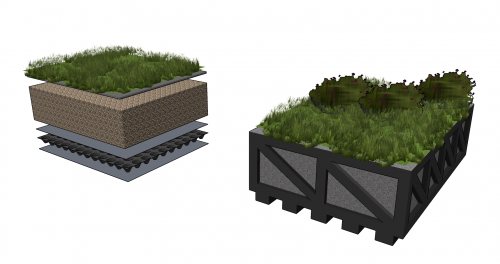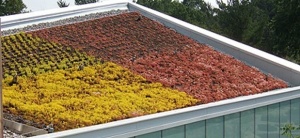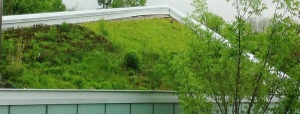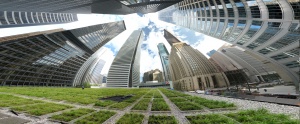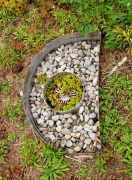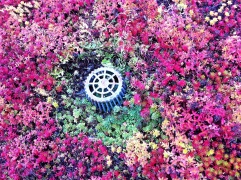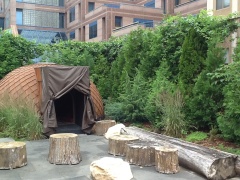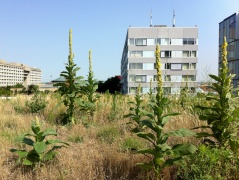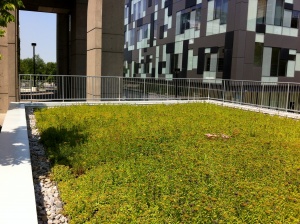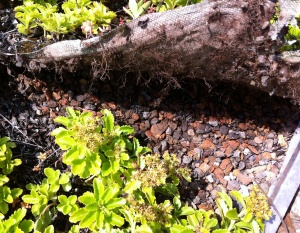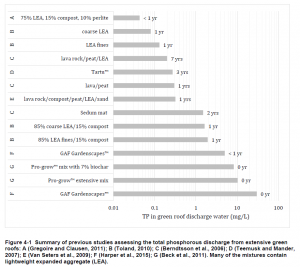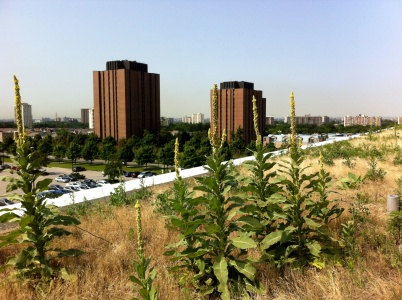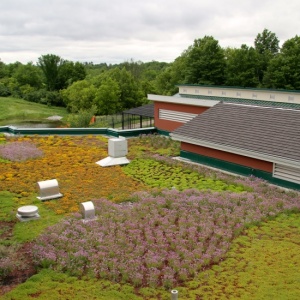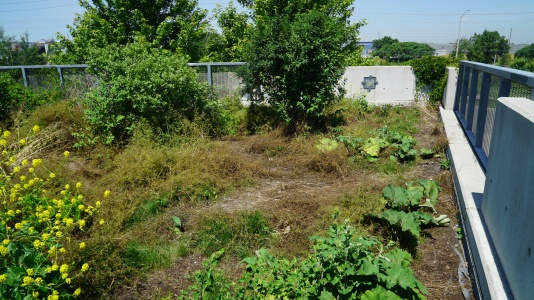Difference between revisions of "Green roofs"
Jenny Hill (talk | contribs) |
|||
| (247 intermediate revisions by 6 users not shown) | |||
| Line 1: | Line 1: | ||
| − | + | [[File:GRmodules.png|thumb|500px|Example schematics of extensive green roofs. On the left, a 'built up' system comprising layers: roofing membrane, drainage board, geotextile, planting medium and sedum mat; and on the right a pre-planted plastic module or tray.]] | |
| − | + | {{TOClimit|2}} | |
| + | ==Overview== | ||
| + | Modern green roofs are a rapidly developing commercial market in Ontario. Their primary benefit as a LID technology is in maximizing [[evapotranspiration]] for water balance targets. | ||
| − | Green | + | Take a look at the downloadable Green Roofs Planning and Design Factsheet below for an overview of this LID best management practice: |
| − | |||
| − | |||
| − | |||
| − | |||
| − | + | {{Clickable button|[[File:G.R.png|125 px|link=https://wiki.sustainabletechnologies.ca/images/b/be/LID_poster_-_Green_Roof_final.pdf]]}} | |
| − | |||
| − | |||
| − | |||
| − | |||
| + | Green roofs are sometimes referred to as 'eco-roofs', 'vegetated roofs', or 'living roofs'. | ||
| + | {{textbox|Green roofs are ideal for: | ||
| + | *Sites without significant space at ground level for infiltration, | ||
| + | *Zero-lot line projects with outdoor amenity requirements, | ||
| + | *Projects looking for accreditation with LEED v.4}} | ||
| − | + | Extensive green roofs are the most common type being applied for stormwater management purposes in Ontario. | |
| − | + | Intensive green roofs are commonly used for amenity space on medium- and high-rise residential developments or sometimes as urban farms. They are sometimes referred to as roof gardens and encompass diverse uses, design priorities and technical specifications. In the most extreme examples, many urban parkettes including large shade trees may be included in this class, if they have parking garages beneath. As such the discussion on this page is limited to extensive green roofs. | |
| − | |||
| − | = | + | {|class="wikitable" |
| − | + | |+ Types of green roofs: defined by construction depth | |
| − | < | + | |- |
| − | + | !Property | |
| − | + | !Extensive | |
| − | + | !Intensive | |
| − | + | |- | |
| − | + | !Planting medium depth | |
| − | + | |10 - 15 cm||> 15 cm | |
| − | + | |- | |
| − | + | !Loading | |
| − | < | + | |up to ~250 kg/m<sup>2</sup>||Limitless where 'roof' is at ground level |
| − | + | |- | |
| + | !Cost | ||
| + | |Typically lower||Higher, including structural accommodations and plant selection | ||
| + | |- | ||
| + | !Maintenance | ||
| + | |Depends highly on the aesthetic expectations of stakeholders||Will be comparable to other landscapes, depending on access requirements. | ||
| + | |- | ||
| + | !Stormwater benefit | ||
| + | |Provides best cost-benefit balance||Varies highly | ||
| + | |- | ||
| + | !Biodiversity benefit | ||
| + | |Lower, depends on planting||Greater potential, depends on planting | ||
| + | |- | ||
| + | !Amenity benefit | ||
| + | |Usually visual only<br>i.e. inaccessible||Often accessible | ||
| + | |} | ||
| − | + | '''The fundamental components of an extensive green roof are:''' | |
| − | + | *a roof structure able to support the design load | |
| − | + | *a waterproof membrane resistant to root penetration | |
| + | *a drainage layer | ||
| + | *a filter layer | ||
| + | *a layer of planting medium | ||
| + | *plants | ||
| − | - | + | '''Additional components may include:''' |
| + | *an irrigation system | ||
| + | *pre-formed tray modules | ||
| − | == | + | ==Planning considerations== |
| + | [[File:TBG2005.jpg|thumb|Sloped extensive green roof at Toronto Botanical Gardens, designed with four species of Sedum (Image: Terry McGlade)]] | ||
| + | [[File:TBG2014.jpg|thumb|Same extensive green roof illustrating the increased biodiversity resulting from very light maintenance over 10 years]] | ||
| − | + | Green roofs offer a variety of co-benefits beyond stormwater management. In urban centers they are often constructed to accommodate a roof terrace or amenity space. In this scenario, the direct stormwater capture benefit is restricted to the areas with vegetation planted. Another increasingly popular use for rooftop space is for urban farming. Again, the direct stormwater capture benefit is restricted to the areas with planters. | |
| + | To maximize the utility of a green roof as a low impact development tool, coverage with planting should be maximized. In many cases this means only inaccessible spaces are used. | ||
| + | ===Amenity=== | ||
| + | Roof gardens with a high proportion of impermeable surface are popular in high rise developments. These amenity terraces are often described as green roofs, but the LID benefit applies only to the vegetated areas. The stormwater benefit of all kinds of green roofs is maximized by combined with [[rainwater harvesting]] for subsequent irrigation. Sedum and native species have all been shown to thrive with daily irrigation to saturation<ref>University of Toronto. 2017. gritlab. https://grit.daniels.utoronto.ca/</ref>. | ||
| − | + | Rooftop farming is also becoming common in some Ontario cities. Again consideration should be given to the proportion of the roof actually planted. Where large open expanses of roof are being cropped, measures may be required to reduce erosion of exposed planting medium. Any digging or furrows will reduce the stormwater benefit. | |
| − | |||
| − | |||
| + | ===Biodiversity=== | ||
| + | Biodiversity opportunities are optimized by planting a variety of species. General advice on this has been prepared by the City of Toronto<ref>City of Toronto. 2017. Biodiverse Green Roofs. https://www.toronto.ca/city-government/planning-development/official-plan-guidelines/green-roofs/biodiverse-green-roofs/</ref>. In the long term, the richness of species increases owing to 'volunteer species'. The desirability of this diversity varies with the aesthetic concerns of the green roof owner. | ||
| − | + | ==Design== | |
| + | [[File:TD Bank.jpg|thumb|The vegetation on this extensive green roof is designed to withstand the deep shade of being in downtown Toronto.]] | ||
| − | === | + | ===Roof=== |
| − | + | Flat roofs should be graded without depressions, with positive drainage ≥ 2% (1:50) towards roof drains. For roofs with pitch greater than 10 % (1:10) additional geo grid or cellular components should be included in the design. These structures reduce the flow rate of the draining water, and help to stabilize green roof components. Green roofs can be installed on slopes greater than 20 % (1:5), but specialized design advice should be sought for the addition of components required to secure the green roof in place. | |
| − | + | Extensive green roofs do not require additional insulation layers. The underlying roof may be of warm, cold or inverted design. | |
| − | < | + | Extensive green roofs add load of around 70 - 300 kg/m<sup>2</sup>. A structural engineer should be consulted during design to account for the distributed loads including [[Winter|snow]] accumulation and live loads including maintenance staff. |
| + | Roof membranes should be waterproof, root resistant, resilient to temperature change, and comply with appropriate CGSB standards as specified in the Ontario Building Code. In most cases a new roof with a modern membrane will not require a separate root penetration barrier. In retrofit scenarios an additional root barrier may be recommended to protect an older roof membrane. | ||
| − | + | ===Drainage Layer=== | |
| − | + | The underlying drainage layer is most often a preformed plastic sheet, formed to include depressions for water storage and perforations to drain excess water. This design has the advantage of being most lightweight, but has minimal impact on flow rates once the water has percolated onto the roof membrane below. | |
| + | An alternative drainage layer solution is to use a granular medium to increase the tortuosity of the flow path and slow peak flow rates. | ||
| − | === | + | ===Filter Layer=== |
| − | < | + | The [[Geotextiles| geotextile]] layer is included to prevent migration of the planting medium into the drainage layer. Current advice is to specify a free draining textile to prevent potential water-logging of the planting medium. Observations green roof assemblies have shown a reduction of flow from specifications owing to interactions of medium particles with the textile. |
| − | + | ||
| − | </ | + | ===Growing Medium=== |
| − | ---- | + | {{:Green_roof_media}} |
| − | === | + | |
| − | [https:// | + | ===Irrigation=== |
| − | < | + | Regular irrigation has been shown to substantially reduce the stormwater capture benefit of an extensive green roof<ref name=Hill/>. |
| − | + | One way to reduce the irrigation used on green roofs is through the use of smart technologies. Responsive sensors that suppress irrigation after a rainstorm are routinely attached to green roofs to conserve water. Improvements can be made by instead using a 'soil' moisture sensor to trigger irrigation. State-of-the-art management systems now use predicted weather data to suppress irrigation ahead of storm events, see [[digital technologies]]. | |
| − | + | Due to their limited water retention capacity, many green roofs are coupled with a rainwater harvesting cistern, to capture the excess water. It then becomes desirable to use as much harvested water to regain the cistern capacity, Green roofs can be irrigated to saturation daily throughout the growing season without damaging the vegetation. | |
| − | < | + | |
| − | < | + | {|class="wikitable" |
| − | < | + | |- |
| − | + | !Irrigation technology | |
| + | !Benefits | ||
| + | !Disadvantages | ||
| + | |- | ||
| + | !Spray | ||
| + | |Maximizes evaporation||Requires higher water quality | ||
| + | |- | ||
| + | !Drip or capillary | ||
| + | |Harvested rainwater is readily used without further treatment<br>Uses less water||Planting medium does not 'wick' water sideways readily, so can lead to localized dry areas | ||
| + | |} | ||
| + | |||
| + | Maximizing evaporation with spray irrigation is the faster way to empty a stormwater cistern, and provides some cooling benefit for the building and it's surroundings. | ||
| + | |||
| + | ===Planting=== | ||
| + | The choice of vegetation on an extensive green roof is insignificant in stormwater management compared to the choice of planting medium or the provision of irrigation. The vegetation should be selected to be resilient to both very wet and very dry periods.''Sedum'' species are the most common choice, demonstrating excellent longevity in systems with or without irrigation. | ||
| + | Some projects expect the low growing ''Sedum'' to remain in graphic designs according to species and flower color. This is not a realistic expectation without significant maintenance costs. Instead project stakeholders should be prepared early in the design process to embrace the green roof as a living and evolving ecosystem. Designs which incorporate both ''Sedum'' and native species can help with this. | ||
| + | |||
| + | ===Drains and vegetation free zones=== | ||
| + | Vegetation free areas are often required around the perimeter of the roof to reduce wind uplift, on larger areas requiring firebreaks, for access paths and around drains. To prevent accumulation of sediment and migration of the vegetation, the vegetation free areas should not be filled with decorative aggregate or river rock. Instead concrete pavers or other surfaces that do not actively trap particles will reduce weeding maintenance. | ||
| + | |||
| + | ===Design for ease of maintenance=== | ||
| + | The primary operational concern for operating a green roof is the development of a leak. Green roofs protect the roof membrane from UV damage and should increase the lifespan of the roof. However, in the event that a leak is discovered a section of green roof would have to be removed for access. Some proprietary systems appear to be easier to remove and replace. This may come at a cost, as the rainwater retention of the system is somewhat reliant on continuous coverage of the green roof surface. | ||
| + | |||
| + | Green roofs should receive as little maintenance as possible. Regular inspection is only required to see that the drains are free from obstruction and that the vegetation coverage is adequate to prevent wind erosion. During detailed design, all areas adjacent to the green roof itself should be kept free from granular material. Sediment accumulates in gravel edging, which then permits the vegetation to take root and spread. | ||
| + | |||
| + | <gallery mode="packed"> | ||
| + | Roof Drain.jpg | Example of gravel edging around a roof, which needs weeding. | ||
| + | Red Drain.jpg| Example of gravel edging around a roof drain, which needs weeding. | ||
| + | Native Child.jpg| The amenity value of this roof is enhanced by the tall and climbing plants screening the high safety fences. | ||
| + | PondRd2.jpg| Very light maintenance has permitted a stand of Mullein to develop on this prairie style green roof, increasing the biodiversity value. | ||
| + | </gallery> | ||
| + | |||
| + | ==Green roof plants== | ||
| + | <div class="mw-collapsible-content"> | ||
| + | {{:Green roofs: Planting}} | ||
| + | </div></div> | ||
| + | |||
| + | Aesthetics of the planting should consider that the practice may be viewed from above. | ||
| + | |||
| + | ==Construction== | ||
| + | Refer to the [[Green roof construction]] page for detailed guidance on construction best practices. | ||
| + | |||
| + | ==Inspection and maintenance== | ||
| + | Green roof maintenance is typically greatest in the first two years as plants are becoming established. Vegetation should be monitored to ensure dense coverage becomes established. A warranty on the vegetation should be included in the | ||
| + | construction contract. | ||
| + | Regular operation of a green roof includes: | ||
| + | * [[Green roofs#Irrigation|Irrigation System]]: Watering should be based on actual soil moisture conditions as plants are designed to be drought tolerant. High soil moisture from unnecessary watering will reduce the runoff reduction benefits of the green roof. | ||
| + | * [[Green roofs#Design|Leak Detection]]: Electronic leak detection is recommended. This system, also used with traditional roofs, must be installed prior to the green roof. Particular attention to leak detection should be paid in the first few months following installation (The Folsom Group, 2004). | ||
| + | Ongoing maintenance should occur at least twice per year (Magco, 2003) and should | ||
| + | include: | ||
| + | * [[Green roofs#Design for Maintenance|Weeding]]: Remove volunteer seedlings of trees and shrubs. Extensive green roofs are not designed for the weight of these plants, and the woody roots can damage the waterproofing. | ||
| + | * [[Green roofs: Planting|Debris and Dead Vegetation Removal]]: Debris and bird feces should be removed periodically. In particular, the overflow conveyance system should be kept clear. | ||
| + | |||
| + | <br> | ||
| + | Take a look at the [[Inspection and Maintenance: Green Roofs]] page by clicking below for further details about proper inspection and maintenance practices: | ||
| + | |||
| + | {{Clickable button|[[File:Green roofs cover page.PNG|150 px|link=https://wiki.sustainabletechnologies.ca/wiki/Inspection_and_Maintenance:_Green_Roofs]]}} | ||
| + | |||
| + | ==Life cycle costs== | ||
| + | To learn about Life Cycle Costs associated with this practice (i.e. Pre-construction, Excavation, Materials & Installation, Project Management, Overhead, Inspection and Maintenance, Rehabilitation and other associated costs), visit the [[Green Roof: Life Cycle Costs]] page to view a cost estimate for an extensive pre-grown mat green roof. Alternatively you can use the [https://sustainabletechnologies.ca/lid-lcct/ STEP's Low Impact Development Life Cycle Costing Tool (LID LCCT)] to generate cost estimates customized to your own LID stormwater design project specifications. | ||
| + | |||
| + | Take a look at the [[Green Roof: Life Cycle Costs]] page by clicking below for further details: | ||
| + | |||
| + | {{Clickable button|[[File:Construction Breakdown GreenRoof No Infil.PNG|150 px|link=https://wiki.sustainabletechnologies.ca/wiki/Green_Roof:_Life_Cycle_Costs]]}} | ||
| + | |||
| + | ==Performance== | ||
| + | [[File:YorkU1.jpg|thumb|Recently laid ''Sedum'' mats on a ground level podium roof.]] | ||
| + | [[File:YorkU2.jpg|thumb|Detail showing the early root development through the mat to the granular planting medium.]] | ||
| + | |||
| + | {| class="wikitable" | ||
| + | |+ Ability of green roofs to meet SWM objectives | ||
| + | |- | ||
| + | !Water balance benefit | ||
| + | !Water quality improvement | ||
| + | !Erosion control benefit | ||
| + | |- | ||
| + | |Partial: Through interception and evapotranspiration | ||
| + | |No: Green roof runoff may contain elevated concentrations of some contaminants, particularly dissolved [[Phosphorus]], Nitrogen and [[Heavy metals]]. | ||
| + | |Partial: Through interception and evapotranspiration | ||
| + | |} | ||
| + | ===Water Balance=== | ||
| + | Green roofs are primarily a practice used to partially achieve water balance and erosion control objectives through interception and [[Evapotranspiration| evapotranspiration]] of precipitation that falls on the roof. The key hydrologic benefit which green roofs have over other forms of LID is the proportion of the water returned to the atmosphere through [[Evapotranspiration| evapotranspiration]]. Considerable research has been conducted in recent years to define the runoff reduction or water retention capacity of extensive green roofs in climates similar to those that occur in Ontario and Canada. | ||
| + | |||
| + | * Controlled studies have indicated that maturing green roofs may have improved water retention properties <ref>De-Ville, S., Menon, M., Jia, X., Reed, G., Stovin, V. 2017. The impact of green roof ageing on substrate characteristics and hydrological performance. Journal of Hydrology. Volume 547. pp 332-344. https://doi.org/10.1016/j.jhydrol.2017.02.006.</ref>. | ||
| + | * In Southern Ontario rainwater retention of extensive green roofs without irrigation is between 57% and 70%<ref>Liu, M. Minor, J. 2005. Performance evaluation of an extensive green roof. National Research Council of Canada. NRCC-48204 https://sustainabletechnologies.ca/app/uploads/2013/03/NRC_EastviewGRrept.pdf</ref> <ref name=VS>Van Seters, T., Rocha, L., Smith, D., MacMillan, G. 2009. Evaluation of Green Roofs for Runoff Retention, Runoff Quality, and Leachability, Vol. 44 (1): 33 - 47 (2009). Innovative Approaches to Stormwater Management in Canada https://sustainabletechnologies.ca/app/uploads/2013/03/WaterQualResearchJournalCanada_YorkU-Greenroof.pdf</ref> <ref name=Hill>Hill J, Drake J, Sleep B, Margolis L. Influences of Four Extensive Green Roof Design Variables on Stormwater Hydrology. J Hydrol Eng. 2017;22(8):04017019. doi:10.1061/(ASCE)HE.1943-5584.0001534</ref>. | ||
| + | * Including winter periods with snow accumulation and thaw, the annual retention of extensive green roofs is around 50% <ref name=VS/><ref name=Hill/>. | ||
| + | * Using a compost based planting medium improves retention by around 10% (i.e., 60% for compost compared to 50% for granular). | ||
| + | * Daily irrigation can reduce the annual retention by 20% compared to a roof without irrigation (i.e., 40% for irrigated compared to 60% without irrigation)<ref name=Hill/>. However, recirculating rainwater from a cistern was estimated to double the annual retention in Florida<ref>Hardin, M.; Wanielista, M.; Chopra, M. 2012. A Mass Balance Model for Designing Green Roof Systems that Incorporate a Cistern for Re-Use. Water, 4, 914-931. http://www.mdpi.com/2073-4441/4/4/914</ref>. The research team modelled 87% retention for a green roof coupled with a cistern, compared to 43% for the green roof alone. | ||
| + | |||
| + | An appropriate NRCS curve number for modelling green roofs without irrigation in Southern Ontario is 90 <ref> | ||
| + | Fassman-Beck, E., Hunt, W., P.E. Robert Berghage, R., Donald Carpenter, D., Kurtz, T., Stovin, V., Wadzuk, B. 2016. Curve Number and Runoff Coefficients for Extensive Living Roofs. Journal of Hydrologic Engineering. Vol.21. Issue 3. ASCE. https://ascelibrary.org/doi/abs/10.1061/(ASCE)HE.1943-5584.0001318</ref> <ref name=Hill/>. | ||
| + | |||
| + | In a study to investigate how green roof runoff reduction performance is affected by climate, Talebi et al. (2019) used water balance and evapotranspiration models to simulate runoff produced by green roofs in six Canadian cities (Vancouver, Calgary, Regina, Toronto, London and Halifax). Results showed that predicted runoff reduction performance varied from 17% to 50% for low water use plants. The best performance was predicted to occur in Regina and Calgary (drier climates), while the poorest performance was predicted for Halifax and Vancouver (wetter climates). Average annual runoff reduction was highest in Toronto and London and lowest in Vancouver.<ref>Talebi, A., Bagg, S., Sleep, B.S., O'Carroll, D.M. 2019. Water retention performance of green roof technology: A comparison of Canadian climates. Ecological Engineering, 126, (2019), 1-15. https://www.sciencedirect.com/science/article/abs/pii/S0925857418303835?via%3Dihub</ref> | ||
| + | |||
| + | ===Water Quality=== | ||
| + | Many green roofs receive only rainwater, which is relatively free of contaminants like nutrients and heavy metals, but can contribute contaminants to roof runoff, most notably through leaching of dissolved [[Nutrients]] and [[Heavy metals]] from the growing medium substrate during early establishment.<ref>Hathaway, A.M., Hunt, W.F., Jennings, G.D. 2008. A field study of green roof hydrologic and water quality performance. Transactions of the ASABE. Vol. 51 (1) pp. 1-8. https://elibrary.asabe.org/abstract.asp?aid=24225</ref> <ref>Vijayaraghavan, K., Harkishore Kumar Reddy, D., Yun, Y. 2018. Improving the quality of runoff from green roofs through synergistic biosorption and phytoremediation techniques: A review. Sustainable Cities and Society. 46 (2019) 101381. https://www.sciencedirect.com/science/article/abs/pii/S2210670718319383?via%3Dihub</ref> Concentrations of Total [[Phosphorus]] in green roof runoff have been observed to vary from 0.4 mg/L to over 10 mg/L.<ref>Hill J., Drake J., Sleep B., Margolis L. 2017. Influences of Four Extensive Green Roof Design Variables on Stormwater Hydrology. J Hydrol Eng. 2017;22(8):04017019. https://ascelibrary.org/doi/abs/10.1061/%28ASCE%29HE.1943-5584.0001534</ref>. Such concentrations are well above the Ontario Provincial Water Quality Objective of 0.03 mg/L for Total Phosphorus (OMOEE, 1994<ref>Ontario Ministry of Environment and Energy (OMOEE), 1994. Policies, Guidelines and Provincial Water Quality Objectives of the Ministry of Environment and Energy. Queen’s Printer for Ontario. Toronto, ON.</ref>) to control excessive plant growth in rivers and streams. To improve the quality of runoff from green roofs, Vijayaraghavan et al. (2018) recommend considering the sorption capacity of the growing medium substrate, the phytoremediation potential of plants, and incorporation of sorbent [[Additives]] to growing medium substrates.<ref>Vijayaraghavan, K., Harkishore Kumar Reddy, D., Yun, Y. 2018. Improving the quality of runoff from green roofs through synergistic biosorption and phytoremediation techniques: A review. Sustainable Cities and Society. 46 (2019) 101381. https://www.sciencedirect.com/science/article/abs/pii/S2210670718319383?via%3Dihub</ref> | ||
| + | |||
| + | In dense urban centres, green roofs are increasingly being used to receive irrigation from harvested rainwater. Current Ontario Building Code permits the use of rooftop runoff for landscape irrigation purposes, so long as it is 'free of solids'. | ||
| + | A 'closed loop' system can be created by coupling a rainwater harvesting system with a green roof and harvesting and reusing roof runoff as a source of water for irrigation during dry periods, so the only water leaving the system is through evapotranspiration. This can prevent runoff from leaving the site and thereby prevent contaminant loading to the environment. | ||
| + | |||
| + | [[File:TP.PNG|thumb|Total phosphorous concentrations reported in green roof runoff(abstracted from Hill 2017)]] | ||
| + | |||
| + | ==Incentives and credits== | ||
| + | ===In Ontario=== | ||
| + | City of Toronto updated their [https://www.toronto.ca/services-payments/water-environment/environmental-grants-incentives/green-your-roof/ Eco-roof incentive program] in 2017. It now includes grants for green roof and cool roof structural assessments and is available to non-profit organizations.<ref>City of Toronto. 2017. Eco-roof Incentive Program. https://www.toronto.ca/services-payments/water-environment/environmental-grants-incentives/green-your-roof/</ref> | ||
| + | |||
| + | ===LEED BD + C v.4=== | ||
| + | <poem> | ||
| + | LEED offer a relatively large number of points for green roofs compared to other LID technologies. | ||
| + | [http://www.usgbc.org/node/2613129?return=/credits '''Sustainable Sites: Open space (1 point)'''] | ||
| + | This credit applies to accessible green roofs on tall buildings with little other outdoor space. | ||
| + | [http://www.usgbc.org/node/2758192?return=/credits '''Sustainable Sites: site development - protect or restore habitat (up to 2 points)'''] | ||
| + | This credit applies to green roofs planted with 'native and adapted vegetation' on tall buildings with little other outdoor space | ||
| + | [http://www.usgbc.org/node/2613950?return=/credits '''Sustainable Sites: Heat island reduction (up to 2 points)'''] | ||
| + | Green roofs are weighted as effectively as 'High-Reflectance' roofs in a simple calculation to determine the credit. | ||
| + | </poem> | ||
| + | {{:LEED: Rainwater management}} | ||
| + | |||
| + | ==External links== | ||
| + | *[https://www.greenroofs.org/ Green Roofs for Healthy Cities] | ||
| + | |||
| + | ===Proprietary systems=== | ||
| + | {{:disclaimer}} | ||
| + | *[http://www.ginkgosustainability.com/ Ginkgo Sustainability] | ||
| + | *[http://www.liveroof.com/ LiveRoof] | ||
| + | *[http://www.nlsm.ca/ Next Level Stormwater Management] | ||
| + | *[http://www.vitaroofs.com/ VitaRoofs] | ||
| + | *[https://www.zinco.ca/ Zinco] | ||
| + | *[https://www.soprema.ca/en/sopranature-vegetated-systems/ Soprema] | ||
| + | |||
| + | ==Green roofs gallery== | ||
| + | {{:Green roofs: Gallery}} | ||
| + | |||
| + | ==References== | ||
| + | [[Category:Green infrastructure]] | ||
Latest revision as of 20:27, 2 August 2023
Overview[edit]
Modern green roofs are a rapidly developing commercial market in Ontario. Their primary benefit as a LID technology is in maximizing evapotranspiration for water balance targets.
Take a look at the downloadable Green Roofs Planning and Design Factsheet below for an overview of this LID best management practice:
Green roofs are sometimes referred to as 'eco-roofs', 'vegetated roofs', or 'living roofs'.
Green roofs are ideal for:
- Sites without significant space at ground level for infiltration,
- Zero-lot line projects with outdoor amenity requirements,
- Projects looking for accreditation with LEED v.4
Extensive green roofs are the most common type being applied for stormwater management purposes in Ontario. Intensive green roofs are commonly used for amenity space on medium- and high-rise residential developments or sometimes as urban farms. They are sometimes referred to as roof gardens and encompass diverse uses, design priorities and technical specifications. In the most extreme examples, many urban parkettes including large shade trees may be included in this class, if they have parking garages beneath. As such the discussion on this page is limited to extensive green roofs.
| Property | Extensive | Intensive |
|---|---|---|
| Planting medium depth | 10 - 15 cm | > 15 cm |
| Loading | up to ~250 kg/m2 | Limitless where 'roof' is at ground level |
| Cost | Typically lower | Higher, including structural accommodations and plant selection |
| Maintenance | Depends highly on the aesthetic expectations of stakeholders | Will be comparable to other landscapes, depending on access requirements. |
| Stormwater benefit | Provides best cost-benefit balance | Varies highly |
| Biodiversity benefit | Lower, depends on planting | Greater potential, depends on planting |
| Amenity benefit | Usually visual only i.e. inaccessible |
Often accessible |
The fundamental components of an extensive green roof are:
- a roof structure able to support the design load
- a waterproof membrane resistant to root penetration
- a drainage layer
- a filter layer
- a layer of planting medium
- plants
Additional components may include:
- an irrigation system
- pre-formed tray modules
Planning considerations[edit]
Green roofs offer a variety of co-benefits beyond stormwater management. In urban centers they are often constructed to accommodate a roof terrace or amenity space. In this scenario, the direct stormwater capture benefit is restricted to the areas with vegetation planted. Another increasingly popular use for rooftop space is for urban farming. Again, the direct stormwater capture benefit is restricted to the areas with planters. To maximize the utility of a green roof as a low impact development tool, coverage with planting should be maximized. In many cases this means only inaccessible spaces are used.
Amenity[edit]
Roof gardens with a high proportion of impermeable surface are popular in high rise developments. These amenity terraces are often described as green roofs, but the LID benefit applies only to the vegetated areas. The stormwater benefit of all kinds of green roofs is maximized by combined with rainwater harvesting for subsequent irrigation. Sedum and native species have all been shown to thrive with daily irrigation to saturation[1].
Rooftop farming is also becoming common in some Ontario cities. Again consideration should be given to the proportion of the roof actually planted. Where large open expanses of roof are being cropped, measures may be required to reduce erosion of exposed planting medium. Any digging or furrows will reduce the stormwater benefit.
Biodiversity[edit]
Biodiversity opportunities are optimized by planting a variety of species. General advice on this has been prepared by the City of Toronto[2]. In the long term, the richness of species increases owing to 'volunteer species'. The desirability of this diversity varies with the aesthetic concerns of the green roof owner.
Design[edit]
Roof[edit]
Flat roofs should be graded without depressions, with positive drainage ≥ 2% (1:50) towards roof drains. For roofs with pitch greater than 10 % (1:10) additional geo grid or cellular components should be included in the design. These structures reduce the flow rate of the draining water, and help to stabilize green roof components. Green roofs can be installed on slopes greater than 20 % (1:5), but specialized design advice should be sought for the addition of components required to secure the green roof in place. Extensive green roofs do not require additional insulation layers. The underlying roof may be of warm, cold or inverted design. Extensive green roofs add load of around 70 - 300 kg/m2. A structural engineer should be consulted during design to account for the distributed loads including snow accumulation and live loads including maintenance staff. Roof membranes should be waterproof, root resistant, resilient to temperature change, and comply with appropriate CGSB standards as specified in the Ontario Building Code. In most cases a new roof with a modern membrane will not require a separate root penetration barrier. In retrofit scenarios an additional root barrier may be recommended to protect an older roof membrane.
Drainage Layer[edit]
The underlying drainage layer is most often a preformed plastic sheet, formed to include depressions for water storage and perforations to drain excess water. This design has the advantage of being most lightweight, but has minimal impact on flow rates once the water has percolated onto the roof membrane below. An alternative drainage layer solution is to use a granular medium to increase the tortuosity of the flow path and slow peak flow rates.
Filter Layer[edit]
The geotextile layer is included to prevent migration of the planting medium into the drainage layer. Current advice is to specify a free draining textile to prevent potential water-logging of the planting medium. Observations green roof assemblies have shown a reduction of flow from specifications owing to interactions of medium particles with the textile.
Growing Medium[edit]
The green roof media used in Ontario can be classed according to proportion of composted biological material. Some existing installations use materials which comply with FLL guidelines, whilst others use a much higher proportion of compost[3].
ASTM International have a number of standards relating to various design considerations for green roofs. These standards provide good technical advice on the testing of systems and components. Of particular note are:
- Standard Test Method for Maximum Media Density for Dead Load Analysis of Vegetative (Green) Roof SystemsE2399, and
- Test Method for Saturated Water Permeability of Granular Drainage Media E2396.
When these tests are completed, the results should be interpreted in relation to the objectives of the green roof. A product complying with overseas guidelines may not serve the needs of a green roof installed in Ontario. In particular, the FLL guide recommends green roof media specifications which may not provide optimal stormwater management or vegetation in our region.
In many proprietary systems the default option for planting medium will be a granular material with very low organic matter content. However, many companies can arrange for a high organic matter alternative to be substituted if requested.
Increasing the depth of planting medium from 10 cm to 15 cm has been shown to benefit the vegetation [4], however stormwater retention was not improved with this increase in depth [5]
| Benefits | Disadvantages |
|---|---|
|
|
Irrigation[edit]
Regular irrigation has been shown to substantially reduce the stormwater capture benefit of an extensive green roof[6]. One way to reduce the irrigation used on green roofs is through the use of smart technologies. Responsive sensors that suppress irrigation after a rainstorm are routinely attached to green roofs to conserve water. Improvements can be made by instead using a 'soil' moisture sensor to trigger irrigation. State-of-the-art management systems now use predicted weather data to suppress irrigation ahead of storm events, see digital technologies. Due to their limited water retention capacity, many green roofs are coupled with a rainwater harvesting cistern, to capture the excess water. It then becomes desirable to use as much harvested water to regain the cistern capacity, Green roofs can be irrigated to saturation daily throughout the growing season without damaging the vegetation.
| Irrigation technology | Benefits | Disadvantages |
|---|---|---|
| Spray | Maximizes evaporation | Requires higher water quality |
| Drip or capillary | Harvested rainwater is readily used without further treatment Uses less water |
Planting medium does not 'wick' water sideways readily, so can lead to localized dry areas |
Maximizing evaporation with spray irrigation is the faster way to empty a stormwater cistern, and provides some cooling benefit for the building and it's surroundings.
Planting[edit]
The choice of vegetation on an extensive green roof is insignificant in stormwater management compared to the choice of planting medium or the provision of irrigation. The vegetation should be selected to be resilient to both very wet and very dry periods.Sedum species are the most common choice, demonstrating excellent longevity in systems with or without irrigation. Some projects expect the low growing Sedum to remain in graphic designs according to species and flower color. This is not a realistic expectation without significant maintenance costs. Instead project stakeholders should be prepared early in the design process to embrace the green roof as a living and evolving ecosystem. Designs which incorporate both Sedum and native species can help with this.
Drains and vegetation free zones[edit]
Vegetation free areas are often required around the perimeter of the roof to reduce wind uplift, on larger areas requiring firebreaks, for access paths and around drains. To prevent accumulation of sediment and migration of the vegetation, the vegetation free areas should not be filled with decorative aggregate or river rock. Instead concrete pavers or other surfaces that do not actively trap particles will reduce weeding maintenance.
Design for ease of maintenance[edit]
The primary operational concern for operating a green roof is the development of a leak. Green roofs protect the roof membrane from UV damage and should increase the lifespan of the roof. However, in the event that a leak is discovered a section of green roof would have to be removed for access. Some proprietary systems appear to be easier to remove and replace. This may come at a cost, as the rainwater retention of the system is somewhat reliant on continuous coverage of the green roof surface.
Green roofs should receive as little maintenance as possible. Regular inspection is only required to see that the drains are free from obstruction and that the vegetation coverage is adequate to prevent wind erosion. During detailed design, all areas adjacent to the green roof itself should be kept free from granular material. Sediment accumulates in gravel edging, which then permits the vegetation to take root and spread.
Green roof plants[edit]
| Scientific name | Common name | Soil Moisture
1=Dry 2=Med 3=Wet |
Partial shade tolerance | Colour |
|---|---|---|---|---|
| Achillea millefolium | Yarrow | 1-2 | O | |
| Allium schonaprasum | Chives | 2-3 | 1 | |
| Aquilegia canadensis | Wild columbine | 1-3 | Y | 1 |
| Calendula sp. | Marigold | 2 | 2 | |
| Carex sp. | Sedge | 3 | Y | O |
| Centaurea sp. | Bluet | 1-2 | 3 | |
| Coreopsis grandiflora 'Early sunrise' | Large-flowered tickseed | 1-2 | 2 | |
| Coreopsis lanceolata | Lanceleaf coreopsis | 1-2 | 2 | |
| Coreopsis tripteris | Tickseed | 1-2 | 2 | |
| Cosmos sp. | Cosmos | 1-3 | 1 | |
| Equisetum hymale | Rough horsetail | 2-3 | Y | O |
| Erysimum sp. | Wallflower | 1-2 | 1 | |
| Geranium maculatum | Wild geranium | 2 | Y | 1 |
| Geranium psilostemon 'Rozanne' | Cranesbill Geranium | 2-3 | Y | 3 |
| Leucanthemum superbum | Shasta daisy | 1-2 | 2 | |
| Liatris spicata | Blazing star | 2 | 3 | |
| Lobelia siphilitica | Blue cardinal flower | 2-3 | Y | 3 |
| Lolium multiflorum | Ryegrass | 1-3 | Y | O |
| Lupinus polyphyllus | Large leaf lupin | 1-3 | Y | 3 |
| Monarda fistulosa | Bee balm | 1-3 | 1 | |
| Monarda punctata | Horsemint | 2 | 3 | |
| Panicum virgatum | Switchgrass | 1-3 | O | |
| Papaver rhoeas | Corn poppy | 1-3 | 1 | |
| Penstemon digitalis | White Beardtongue | 1-2 | O | |
| Pycnanthemum tenuifolium | Narrowleaf mountain mint | 1-2 | Y | O |
| Rudbeckia hirta | blackeyed Susan | 1-3 | Y | 2 |
| Rudbeckia nitida 'Herbstsonne' | Cutleaf coneflower | 2 | Y | 2 |
| Rudbeckia laciniata 'Goldquelle' | Golden glow coneflower | 2 | Y | 2 |
| Saponaria officinalis | Soapwort | 2-3 | Y | O |
| Schizachyrium scoparium | Little Bluestem | 2 | O | |
| Sedum sp. | Stonecrop | 1-3 | O | |
| Sempervivum sp. | Houseleek | 1-2 | O | |
| Silene sp. | Campion | 1-2 | Y | O |
| Symphyotrichum novae-angliae | New England Aster | 2 | 3 | |
| Trifolium repens | White clover | 3 | O |
Aesthetics of the planting should consider that the practice may be viewed from above.
Construction[edit]
Refer to the Green roof construction page for detailed guidance on construction best practices.
Inspection and maintenance[edit]
Green roof maintenance is typically greatest in the first two years as plants are becoming established. Vegetation should be monitored to ensure dense coverage becomes established. A warranty on the vegetation should be included in the construction contract. Regular operation of a green roof includes:
- Irrigation System: Watering should be based on actual soil moisture conditions as plants are designed to be drought tolerant. High soil moisture from unnecessary watering will reduce the runoff reduction benefits of the green roof.
- Leak Detection: Electronic leak detection is recommended. This system, also used with traditional roofs, must be installed prior to the green roof. Particular attention to leak detection should be paid in the first few months following installation (The Folsom Group, 2004).
Ongoing maintenance should occur at least twice per year (Magco, 2003) and should include:
- Weeding: Remove volunteer seedlings of trees and shrubs. Extensive green roofs are not designed for the weight of these plants, and the woody roots can damage the waterproofing.
- Debris and Dead Vegetation Removal: Debris and bird feces should be removed periodically. In particular, the overflow conveyance system should be kept clear.
Take a look at the Inspection and Maintenance: Green Roofs page by clicking below for further details about proper inspection and maintenance practices:
Life cycle costs[edit]
To learn about Life Cycle Costs associated with this practice (i.e. Pre-construction, Excavation, Materials & Installation, Project Management, Overhead, Inspection and Maintenance, Rehabilitation and other associated costs), visit the Green Roof: Life Cycle Costs page to view a cost estimate for an extensive pre-grown mat green roof. Alternatively you can use the STEP's Low Impact Development Life Cycle Costing Tool (LID LCCT) to generate cost estimates customized to your own LID stormwater design project specifications.
Take a look at the Green Roof: Life Cycle Costs page by clicking below for further details:
Performance[edit]
| Water balance benefit | Water quality improvement | Erosion control benefit |
|---|---|---|
| Partial: Through interception and evapotranspiration | No: Green roof runoff may contain elevated concentrations of some contaminants, particularly dissolved Phosphorus, Nitrogen and Heavy metals. | Partial: Through interception and evapotranspiration |
Water Balance[edit]
Green roofs are primarily a practice used to partially achieve water balance and erosion control objectives through interception and evapotranspiration of precipitation that falls on the roof. The key hydrologic benefit which green roofs have over other forms of LID is the proportion of the water returned to the atmosphere through evapotranspiration. Considerable research has been conducted in recent years to define the runoff reduction or water retention capacity of extensive green roofs in climates similar to those that occur in Ontario and Canada.
- Controlled studies have indicated that maturing green roofs may have improved water retention properties [7].
- In Southern Ontario rainwater retention of extensive green roofs without irrigation is between 57% and 70%[8] [9] [6].
- Including winter periods with snow accumulation and thaw, the annual retention of extensive green roofs is around 50% [9][6].
- Using a compost based planting medium improves retention by around 10% (i.e., 60% for compost compared to 50% for granular).
- Daily irrigation can reduce the annual retention by 20% compared to a roof without irrigation (i.e., 40% for irrigated compared to 60% without irrigation)[6]. However, recirculating rainwater from a cistern was estimated to double the annual retention in Florida[10]. The research team modelled 87% retention for a green roof coupled with a cistern, compared to 43% for the green roof alone.
An appropriate NRCS curve number for modelling green roofs without irrigation in Southern Ontario is 90 [11] [6].
In a study to investigate how green roof runoff reduction performance is affected by climate, Talebi et al. (2019) used water balance and evapotranspiration models to simulate runoff produced by green roofs in six Canadian cities (Vancouver, Calgary, Regina, Toronto, London and Halifax). Results showed that predicted runoff reduction performance varied from 17% to 50% for low water use plants. The best performance was predicted to occur in Regina and Calgary (drier climates), while the poorest performance was predicted for Halifax and Vancouver (wetter climates). Average annual runoff reduction was highest in Toronto and London and lowest in Vancouver.[12]
Water Quality[edit]
Many green roofs receive only rainwater, which is relatively free of contaminants like nutrients and heavy metals, but can contribute contaminants to roof runoff, most notably through leaching of dissolved Nutrients and Heavy metals from the growing medium substrate during early establishment.[13] [14] Concentrations of Total Phosphorus in green roof runoff have been observed to vary from 0.4 mg/L to over 10 mg/L.[15]. Such concentrations are well above the Ontario Provincial Water Quality Objective of 0.03 mg/L for Total Phosphorus (OMOEE, 1994[16]) to control excessive plant growth in rivers and streams. To improve the quality of runoff from green roofs, Vijayaraghavan et al. (2018) recommend considering the sorption capacity of the growing medium substrate, the phytoremediation potential of plants, and incorporation of sorbent Additives to growing medium substrates.[17]
In dense urban centres, green roofs are increasingly being used to receive irrigation from harvested rainwater. Current Ontario Building Code permits the use of rooftop runoff for landscape irrigation purposes, so long as it is 'free of solids'. A 'closed loop' system can be created by coupling a rainwater harvesting system with a green roof and harvesting and reusing roof runoff as a source of water for irrigation during dry periods, so the only water leaving the system is through evapotranspiration. This can prevent runoff from leaving the site and thereby prevent contaminant loading to the environment.
Incentives and credits[edit]
In Ontario[edit]
City of Toronto updated their Eco-roof incentive program in 2017. It now includes grants for green roof and cool roof structural assessments and is available to non-profit organizations.[18]
LEED BD + C v.4[edit]
LEED offer a relatively large number of points for green roofs compared to other LID technologies.
Sustainable Sites: Open space (1 point)
This credit applies to accessible green roofs on tall buildings with little other outdoor space.
Sustainable Sites: site development - protect or restore habitat (up to 2 points)
This credit applies to green roofs planted with 'native and adapted vegetation' on tall buildings with little other outdoor space
Sustainable Sites: Heat island reduction (up to 2 points)
Green roofs are weighted as effectively as 'High-Reflectance' roofs in a simple calculation to determine the credit.
Sustainable sites: Rainwater management (up to 3 points)
- Two points (or 1 point for Healthcare) will be awarded if the project manages "the runoff from the developed site for the 95th percentile of regional or local rainfall events."
- Three points (or 2 points for Healthcare) will be awarded if the project manages "the runoff from the developed site for the 98th percentile of regional or local rainfall events."
OR
- For zero-lot-line projects only, 3 points (or 2 points for Healthcare) will be awarded if the project manages "the runoff from the developed site for the 85th percentile of regional or local rainfall events."
External links[edit]
Proprietary systems[edit]
In our effort to make this guide as functional as possible, we have decided to include proprietary systems and links to manufacturers websites.
Inclusion of such links does not constitute endorsement by the Sustainable Technologies Evaluation Program.
Lists are ordered alphabetically; link updates are welcomed using the form below.
Green roofs gallery[edit]
References[edit]
- ↑ University of Toronto. 2017. gritlab. https://grit.daniels.utoronto.ca/
- ↑ City of Toronto. 2017. Biodiverse Green Roofs. https://www.toronto.ca/city-government/planning-development/official-plan-guidelines/green-roofs/biodiverse-green-roofs/
- ↑ Hill, J., Drake, J., and Sleep, B. (2016). “Comparisons of extensive green roof media in Southern Ontario.” Ecological Engineering, Elsevier B.V., 94, 418–426. https://www.sciencedirect.com/science/article/abs/pii/S0925857416302804?via%3Dihub
- ↑ MacIvor JS, Margolis L, Puncher CL, Carver Matthews BJ. Decoupling factors affecting plant diversity and cover on extensive green roofs. J Environ Manage. 2013;130:297-305. https://www.sciencedirect.com/science/article/abs/pii/S0301479713006051?via%3Dihub
- ↑ Hill, J., Drake, A. P. J., Sleep, B., and Margolis, L. (2017). “Influences of Four Extensive Green Roof Design Variables on Stormwater Hydrology.” Journal of Hydrologic Engineering. https://ascelibrary.org/doi/abs/10.1061/%28ASCE%29HE.1943-5584.0001534
- ↑ 6.0 6.1 6.2 6.3 6.4 Hill J, Drake J, Sleep B, Margolis L. Influences of Four Extensive Green Roof Design Variables on Stormwater Hydrology. J Hydrol Eng. 2017;22(8):04017019. doi:10.1061/(ASCE)HE.1943-5584.0001534
- ↑ De-Ville, S., Menon, M., Jia, X., Reed, G., Stovin, V. 2017. The impact of green roof ageing on substrate characteristics and hydrological performance. Journal of Hydrology. Volume 547. pp 332-344. https://doi.org/10.1016/j.jhydrol.2017.02.006.
- ↑ Liu, M. Minor, J. 2005. Performance evaluation of an extensive green roof. National Research Council of Canada. NRCC-48204 https://sustainabletechnologies.ca/app/uploads/2013/03/NRC_EastviewGRrept.pdf
- ↑ 9.0 9.1 Van Seters, T., Rocha, L., Smith, D., MacMillan, G. 2009. Evaluation of Green Roofs for Runoff Retention, Runoff Quality, and Leachability, Vol. 44 (1): 33 - 47 (2009). Innovative Approaches to Stormwater Management in Canada https://sustainabletechnologies.ca/app/uploads/2013/03/WaterQualResearchJournalCanada_YorkU-Greenroof.pdf
- ↑ Hardin, M.; Wanielista, M.; Chopra, M. 2012. A Mass Balance Model for Designing Green Roof Systems that Incorporate a Cistern for Re-Use. Water, 4, 914-931. http://www.mdpi.com/2073-4441/4/4/914
- ↑ Fassman-Beck, E., Hunt, W., P.E. Robert Berghage, R., Donald Carpenter, D., Kurtz, T., Stovin, V., Wadzuk, B. 2016. Curve Number and Runoff Coefficients for Extensive Living Roofs. Journal of Hydrologic Engineering. Vol.21. Issue 3. ASCE. https://ascelibrary.org/doi/abs/10.1061/(ASCE)HE.1943-5584.0001318
- ↑ Talebi, A., Bagg, S., Sleep, B.S., O'Carroll, D.M. 2019. Water retention performance of green roof technology: A comparison of Canadian climates. Ecological Engineering, 126, (2019), 1-15. https://www.sciencedirect.com/science/article/abs/pii/S0925857418303835?via%3Dihub
- ↑ Hathaway, A.M., Hunt, W.F., Jennings, G.D. 2008. A field study of green roof hydrologic and water quality performance. Transactions of the ASABE. Vol. 51 (1) pp. 1-8. https://elibrary.asabe.org/abstract.asp?aid=24225
- ↑ Vijayaraghavan, K., Harkishore Kumar Reddy, D., Yun, Y. 2018. Improving the quality of runoff from green roofs through synergistic biosorption and phytoremediation techniques: A review. Sustainable Cities and Society. 46 (2019) 101381. https://www.sciencedirect.com/science/article/abs/pii/S2210670718319383?via%3Dihub
- ↑ Hill J., Drake J., Sleep B., Margolis L. 2017. Influences of Four Extensive Green Roof Design Variables on Stormwater Hydrology. J Hydrol Eng. 2017;22(8):04017019. https://ascelibrary.org/doi/abs/10.1061/%28ASCE%29HE.1943-5584.0001534
- ↑ Ontario Ministry of Environment and Energy (OMOEE), 1994. Policies, Guidelines and Provincial Water Quality Objectives of the Ministry of Environment and Energy. Queen’s Printer for Ontario. Toronto, ON.
- ↑ Vijayaraghavan, K., Harkishore Kumar Reddy, D., Yun, Y. 2018. Improving the quality of runoff from green roofs through synergistic biosorption and phytoremediation techniques: A review. Sustainable Cities and Society. 46 (2019) 101381. https://www.sciencedirect.com/science/article/abs/pii/S2210670718319383?via%3Dihub
- ↑ City of Toronto. 2017. Eco-roof Incentive Program. https://www.toronto.ca/services-payments/water-environment/environmental-grants-incentives/green-your-roof/
